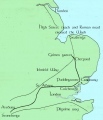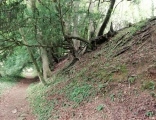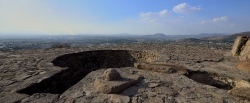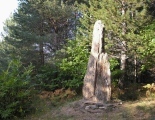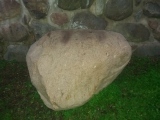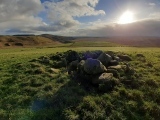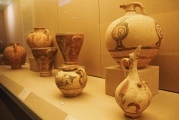Andy Burnham's Blog, page 182
December 7, 2020
The Puddingstone Trail - fact or fantasy?
Mike Burgess has completed his nine-year project examining Dr. Ernest Rudge's doubtful Puddingstone Track theory. The write-up is now available on his web site Hidden East Anglia. Mike has photographed and measured every stone he could access from Norfolk to Oxfordshire and finds that sadly the idea doesn't hold water. But as we like cataloguing and 'collecting' stones in the landscape we're glad he did it.. This article was originally published in 2005: Is there a lost Neolithic trade route that took high quality flint from the mines at Grimes Graves to Stonehenge? Dr Ernest Rudge certainly thought so and spent many years researching what he called a "Lost Highway". Rudge located many puddingstone boulders that he thought acted as marker stones along the way. After his death in 1984, his work was summarised by John Cooper of the Department of Palaeontology at London's Natural History Museum. His summary gives a detailed itinerary, much of which I have now plotted on the Megalithic Map. I have John's permission to use information from his publication and he is delighted that further research will continue.
Published on December 07, 2020 12:35
December 6, 2020
Book Review: A Neolithic Universe by Jonathan Morris
This is the third book written by Jonathan Morris. The first, The Broken Stone, is a novel about Stonehenge with an explanation of the science behind the novel and the second, Stonehenge: Solving the Neolithic Universe, explains the science further. The book is a further update, delving deeper into the science and explains why the author thinks Stonehenge could have been constructed to demonstrate a geocentric (i.e. earth-centred) universe. Drawing on many disciplines, including archaeology, history, geology, folklore, and mathematics (the latter being in a very simple form), he puts forward this suggestion in a coherent and easy to understand way.
Published on December 06, 2020 03:34
December 5, 2020
Offa's Dyke near Brockweir
Offas Dyke: A Watery Perspective Video Talk by Prof Howard M R Williams, more on our page. Well preserved and significantly built section of Offa's Dyke high up on the eastern side of the River Wye near the village of Brockweir. The Offa's Dyke path is well used here, and in places offers splendid views over the river to Wales, especially at the well known "Devil's Pulpit" rock stack allowing intrepid visitors a superb vista of Tintern Abbey.
Published on December 05, 2020 05:43
December 4, 2020
Texcotzingo
Aztec Maps Put Cortés to Shame. See comment.. Ancient Palace of the Poet King Netzahualcoyotl which had rock hewn baths, conference rooms, treasury, statues created. Adjacent to the Axtec city of Texcoco, the palace included gardens watered by an extensive hydraulic system, which were decorated by statues and carvings associating the gardens Aztec mythology.
Published on December 04, 2020 14:13
December 2, 2020
Rougeiresque menhir
This super menhir, on the Corniche-des-Cévennes ridgetop, is about 3.5 metres tall, made of a nice piece of schist with a quartz vein through the middle. On the south facing side there are many cupules (I counted 15), while on the back face I counted 6. Some of these are quite large, and they mostly form a row up the right hand side of the stone as you look at it for both faces.
Published on December 02, 2020 13:16
December 1, 2020
Askitario
Have you visited this site? Do you have any photographs or further information to add?. Askitario is a prehistoric settlement in Greece dating back to the Helladic era (about 3.000-2.000 BC). It was a fortified triangular Acropolis, with two sides protected by steep cliffs, and the third one possessing a 32 metre wall. The wall was at some points 2 metres thick and it had a height of about 3 metres from the side of the acropolis and 6 metres from the outer side.
Published on December 01, 2020 14:35
November 27, 2020
Ffridd Braich Llwyd Round Cairn
Situated to the south of an ancient trackway this ring cairn in Gwynedd lies within an open upland environment. There are extensive views across the valleys and towards Mynydd Talygannau. CADW has scheduled the monument as part of a Bronze Age ritual complex due to the number of other sites in the area - see the nearby sites list on our page for the others.
Published on November 27, 2020 13:35
Schleifbahnenstein Pasewalk
This stone was found near Pasewalk in Germany during excavations along the European Gas Pipeline Link (EUGAL). The granite block has an irregular ellipsoidal shape and on one side there are three parallel sliding tracks running at right angles to the long side. They are about 12-18 cm wide and 34-48 cm long. The unusually fine cut suggested that they did not arise naturally. There is some evidence that it was used to work on Neolithic stone tools. Also use as a cult / ritual stone cannot be ruled out,
Published on November 27, 2020 13:30
Afon y Dolau Gwynion
Chambered Tomb in Powys. The site is condition 2 only but very peaceful.
Nothing much above knee height, but there is enough to interpret its purpose.
Access by foot or bicycle from Lake Vrnwy.. The route is steep ,passes through a Lot of "cow slurry" and a ford. Then there is a steep climb on grass.
Nothing much above knee height, but there is enough to interpret its purpose.
Access by foot or bicycle from Lake Vrnwy.. The route is steep ,passes through a Lot of "cow slurry" and a ford. Then there is a steep climb on grass.
Published on November 27, 2020 13:23
November 24, 2020
Museum of Prehistoric Thera
A modern museum dedicated to the prehistory of Santorini. Artifacts come in a big part from the Minoan settlement of Akrotiri. Highlights of the museum include a golden ibex statuette and well preserved Minoan frescoes.
Published on November 24, 2020 07:58

